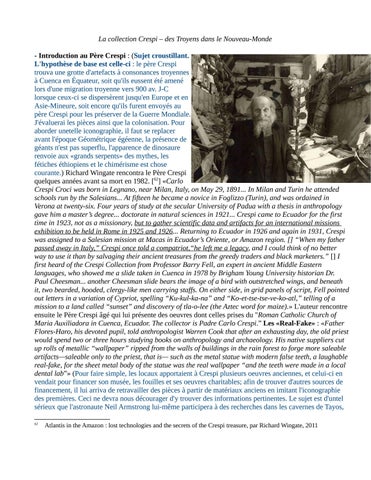La collection Crespi – des Troyens dans le Nouveau-Monde - Introduction au Père Crespi : (Sujet croustillant. L'hypothèse de base est celle-ci : le père Crespi trouva une grotte d'artefacts à consonances troyennes à Cuenca en Équateur, soit qu'ils eussent été amené lors d'une migration troyenne vers 900 av. J-C lorsque ceux-ci se dispersèrent jusqu'en Europe et en Asie-Mineure, soit encore qu'ils furent envoyés au père Crespi pour les préserver de la Guerre Mondiale. J'évaluerai les pièces ainsi que la colonisation. Pour aborder unetelle iconographie, il faut se replacer avant l'époque Géométrique égéenne, la présence de géants n'est pas superflu, l'apparence de dinosaure renvoie aux «grands serpents» des mythes, les fétiches éthiopiens et le chimérisme est chose courante.) Richard Wingate rencontra le Père Crespi quelques années avant sa mort en 1982. [62] «Carlo Crespi Croci was born in Legnano, near Milan, Italy, on May 29, 1891... In Milan and Turin he attended schools run by the Salesians... At fifteen he became a novice in Foglizzo (Turin), and was ordained in Verona at twenty-six. Four years of study at the secular University of Padua with a thesis in anthropology gave him a master’s degree... doctorate in natural sciences in 1921... Crespi came to Ecuador for the first time in 1923, not as a missionary, but to gather scientific data and artifacts for an international missions exhibition to be held in Rome in 1925 and 1926... Returning to Ecuador in 1926 and again in 1931, Crespi was assigned to a Salesian mission at Macas in Ecuador’s Oriente, or Amazon region. [] “When my father passed away in Italy,” Crespi once told a compatriot,“he left me a legacy, and I could think of no better way to use it than by salvaging their ancient treasures from the greedy traders and black marketers.” [] I first heard of the Crespi Collection from Professor Barry Fell, an expert in ancient Middle Eastern languages, who showed me a slide taken in Cuenca in 1978 by Brigham Young University historian Dr. Paul Cheesman... another Cheesman slide bears the image of a bird with outstretched wings, and beneath it, two bearded, hooded, clergy-like men carrying staffs. On either side, in grid panels of script, Fell pointed out letters in a variation of Cypriot, spelling “Ku-kul-ka-na” and “Ko-et-tse-tse-ve-ko-atl,” telling of a mission to a land called “sunset” and discovery of tla-o-lee (the Aztec word for maize).» L'auteur rencontre ensuite le Père Crespi âgé qui lui présente des oeuvres dont celles prises du "Roman Catholic Church of Maria Auxiliadora in Cuenca, Ecuador. The collector is Padre Carlo Crespi.” Les «Real-Fake» : «Father Flores-Haro, his devoted pupil, told anthropologist Warren Cook that after an exhausting day, the old priest would spend two or three hours studying books on anthropology and archaeology. His native suppliers cut up rolls of metallic “wallpaper” ripped from the walls of buildings in the rain forest to forge more saleable artifacts—saleable only to the priest, that is— such as the metal statue with modern false teeth, a laughable real-fake, for the sheet metal body of the statue was the real wallpaper “and the teeth were made in a local dental lab”» (Pour faire simple, les locaux apportaient à Crespi plusieurs oeuvres anciennes, et celui-ci en vendait pour financer son musée, les fouilles et ses oeuvres charitables; afin de trouver d'autres sources de financement, il lui arriva de retravailler des pièces à partir de matériaux anciens en imitant l'iconographie des premières. Ceci ne devra nous décourager d'y trouver des informations pertinentes. Le sujet est d'untel sérieux que l'astronaute Neil Armstrong lui-même participera à des recherches dans les cavernes de Tayos, 62
Atlantis in the Amazon : lost technologies and the secrets of the Crespi treasure, par Richard Wingate, 2011













